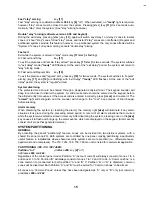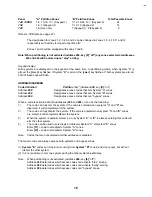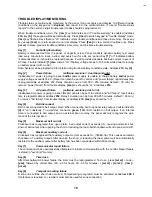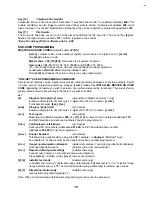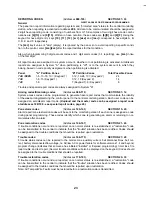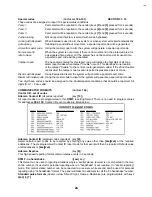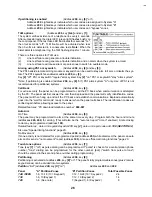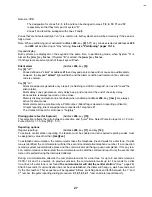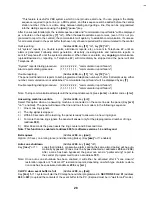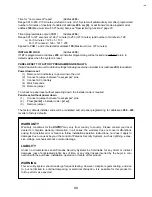
TROUBLE DISPLAY/MONITORING
Trouble status is continuously monitored by the panel. It can recognize and display 10 different trouble
conditions on the keypad or in
Espload, and report 8 to the central station. (To send "trouble status
reports" to the central, 2-digit trouble report codes should be programmed.)
When trouble conditions occur, the [
TRBL
] key illuminates and if "trouble warning" is enabled (address
210, key [9]) the keypad will beep intermittently. Press [
TRBL
] to switch keypad to "trouble display" mode.
[
TRBL
] key flashes. Keys that are "on" indicate current trouble conditions and those in memory. Press any
key except [2
ND
] to return keypad to normal display. Press [2
ND
] to view current troubles only. Press
[
CLEAR
] to erase previous trouble conditions in memory, and to silence trouble warning.
Key [1]
No battery/low battery
Battery is disconnected from the panel, or capacity is low. Panel conducts dynamic battery test under
load every minute for a 4 sec. period, and every hour for a 64 sec. period. Key [1] "on" indicates battery
is disconnected, or it should be replaced because it won't provide adequate back-up current in event of
AC loss. Trouble indicator [1] also comes "on" if battery voltage drops to 10.5 volts while panel is running
on battery power (with no AC).
Note: System can be programmed to inhibit arming if no/low battery condition exists - Address 210, key [4].
Key [2]
Power failure
(software versions 1.4 and beyond only)
Inadequate AC power is going to panel and/or power supply is unable to charge battery and/or power
supply voltage exceeds 14.9V. (Report can also be sent to central, and “power failure” report delay time
is programmable at address 252. Delay duration can be from 000 - 255 minutes; default = 30 min.) To
remove “power failure” from trouble display, [2
ND
] key should be “on” at address 210.
Key [3]
AC power failure
(software versions prior to 1.4)
Inadequate AC power is going to panel. (Report can also be sent to central, and "AC failure" report delay
time is programmable at address 252. Delay's duration can be from 000-255 minutes, default = 30 min.)
To remove "AC failure" from trouble display, at address 210, [2
ND
] key should be "on".
Key [4]
Bell disconnect
Bell is not connected to bell output. Note: When connecting bell to optional relay output, trouble indicator
[4] is "on" constantly. To avoid this, connect a green (1K
W)
EOL resistor on bell output. If an internal
siren is connected to bell output, and an external siren to relay, the panel will only recognize the exis-
tence of the internal siren.
Key [5]
Maximum bell current
Processor has recognized that, upon alarm, bell output current exceeds 3A., causing automatic shut-
down of bell output. After opening the short or reducing the load, bell shut-down will end upon bell cut-off.
Key [6]
Maximum auxiliary current
Processor has recognized that auxiliary output current exceeds 1A. (748ES-3A) This causes automatic
shut-down of auxiliary output. After opening the short or reducing the load, power will be automatically
restored to the auxiliary output after battery test has been conducted (within 60 seconds).
Key [7]
Communicator report failure
The control panel has unsuccessfully attempted to initiate communication with the central. Report failure
is stored in "event list" memory.
Key [8]
Timer loss
After total battery/AC power failure, the timer must be reprogrammed. To do so, press [
ENTER
] + code +
[
MEM
], followed by correct time (00 - 23 for hours, 00 - 59 for minutes) + [
ENTER
] + [
ENTER
] + [
TRBL
] +
[
CLEAR
].
Key [9]
Tamper/zone wiring failure
A zone line cut/line short has occurred. Tamper/wiring recognition must be activated at address 208 if
this feature is required.
EOL
resistors must also be used for zone connection.
18
IM8












